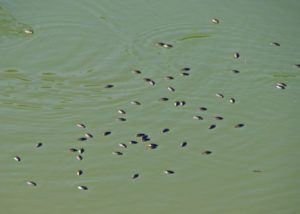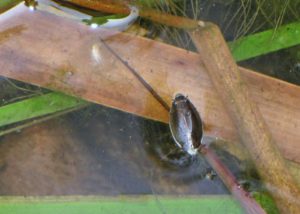Howdy, BugFans,
Here’s an updated BOTW from 10 years ago (more words).
Whirligig beetles are referred to in Kaufman and Eaton’s Field Guide to Insects of North America as the “bumper cars of the beetle world.” Looking like dark watermelon seeds, mobs of whirligig beetles scoot across the still waters of ponds, lakes, and the slower sections of streams and rivers. They are seldom alone, and a very large “school” may contain as many as a dozen different species of whirligigs (there are about 60 species in North America and about 850 others elsewhere).
Whirligigs are in the order Coleoptera (beetles) and in the Family Gyrinidae (which has its roots in the Greek “gyr” meaning “ring,” “circle,” or “spiral”). Most are in either the ½” long genus Dineutes or the ¼” long Gyrinus. Their basic designs are similar – domed elytra (hard wing covers) that end just before the abdomen does, appendages that tuck in so the beetles are streamlined https://bugguide.net/node/view/377432/bgimage, and a shiny, black finish covered by a waxy, water-repellant, outer layer.
Whirligig beetles’ eyes are split – handy for a predator, because half of each eye lies below the water line and half rises above it https://bugguide.net/node/view/758727/bgimage, so they can view two worlds at once. They are pretty impressive on the water’s surface – they row in straight lines and circles with their flattened and fringed middle and hind pairs of legs (they hold their front pair of legs, which are modified for grasping, forward). They are good swimmers underwater, and they migrate from pond to pond by flying https://bugguide.net/node/view/274264/bgimage.
They may dive (or swim in circles) when alarmed, and they can secrete a smelly substance (gyrinidal) that deters predators – a fish that has sampled a whirligig beetle doesn’t try a second one – and also warns nearby whirligigs that danger is afoot. It smells a little like apples, and so these beetles are sometimes called “apple-bugs,” or “apple-smellers.”
When on the surface, they breathe air from the atmosphere, but they tuck an air bubble under their wings when they dive. Because of that air bubble, whirligigs that venture under water must either swim hard or grab aquatic vegetation to keep from popping up to the surface.
To an animal the size of an insect, the top layer of water molecules is a sticky film. For some that live below the surface, it can be a prison that they aren’t strong enough to break through. Whirligigs and water striders and some springtails skate on top of it, snails and leeches glide belly up on its under-surface, but other insects get stuck on it when they fly too close. Whirligig beetles find their food stuck in that film – the last two segments of their stubby antennae https://bugguide.net/node/view/420650/bgimage are used to detect the tiny waves made by insects struggling on the surface film. They also scavenge on floating dead material. In A Guide to Common Freshwater Invertebrates of North America, Voshell surmises that “the waves that the adult whirligig beetles generate when swimming may function for the echolocation of food, like sonar used by ships at sea.”
Ms. Whirligig lays her eggs on underwater plants. Like their parents, the larvae are “engulfer-predators;” they swim or climb on submerged vegetation, eating water mites, snails, worms, and other small aquatic insects (especially mosquito larvae/pupae), as well as their own brethren. They puncture their prey with hollow mandibles and extract the innards. Larvae https://bugguide.net/node/view/1432827/bgimage pick up dissolved oxygen from the water through their skin and also by means of external gills located on the sides of their abdomens.
When they are ready to pupate, they build a case of mud, sand, or leaf pieces, stuck together with gluey saliva, on a damp shoreline. Dineutes adds to the degree of difficulty by doing this upside down, suspended over its building material from vegetation by its posterior hooks (think Houdini in a straitjacket), stretching down to grab one mouthful at a time to construct a pupal case (the BugLady is not making this up!). Adults overwinter at the bottom of their river or pond.
Two other interesting whirligig-facts:
Ann Haven Morgan reports in Field Book of Ponds and Streams that a researcher who fed freshly-killed larvae to captive adult Dineutes observed a piranha-like feeding frenzy. “As many as could would seize the insect, crowd around it, grasping it, whirling around it in wild curves and sometimes diving beneath the surface, but always holding on to their prey and tearing out mouthfuls of insect tissue.”
The charming, second fact, that males can squeak, isn’t quite enough to banish that mental picture.
Apparently, one of the things that alarms them is cameras, and this is another species that has defied the BugLady’s attempts to get an in-focus photograph (thank goodness for the folks at bugguide.net! https://bugguide.net/node/view/1737886/bgimage, https://bugguide.net/node/view/956320/bgimage. On the other hand, since Voshell says that they’ve been clocked at speeds up to 1 meter per second (another source said 44 body lengths/second), the BugLady doesn’t feel so bad.
Kate Redmond, The BugLady
Bug of the Week archives:
http://uwm.edu/field-station/category/bug-of-the-week/


